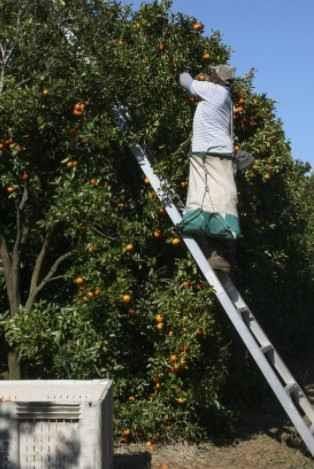By Danielle Sprague
Fall is here so is harvest season! For our fresh produce that is harvested and packed by hand, food safety practices play a major role in protecting consumers. Some growers may be subject to the United States Food and Drug Administration’s Food Safety Modernization Act (FSMA) Produce Safety Rule, while other growers may receive food safety requirements from buyers. Regardless of regulatory or market pressure, food safety is critical to every fresh produce grower (regardless of size, location, or commodities grown), because the produce they market is often consumed raw with no additional processing. It’s important for agricultural workers to know and understand food safety risks, because they are present during harvest and their health and hygiene practices directly affect produce safety.

Hand Harvesting Citrus.
General Recommendations for Worker Health & Hygiene
–
Educate your workers with training!
Make sure workers understand the principles of food hygiene and food safety. This includes when and how to properly wash their hands. It is important for them to maintain personal cleanliness and to be able to recognize the symptoms of foodborne illness, as well as the importance of not coming to work when sick. Workers that are harvesting produce should never harvest fresh market produce with visible feces, or produce that has dropped to the ground before harvest. When training your workers, it is important to use a language workers can understand.

Agricultural workers signing in for a farm food safety training prior to harvest.
Provide the necessary resources needed to implement food safety practices.
If workers don’t have access to toilets, toilet paper, water, soap, and single-use paper towels, then they cannot implement food safety practices. It’s also important to have garbage cans, first aid kits and a designated break area where workers can eat or drink without introducing contamination to fresh produce. For small farms, these facilities could be located inside the home or office, assuming the resources mentioned above are provided.
–
Educate any visitors on your farm.
Visitors such as you-pick customers, agricultural tour groups, school groups, or any person (other than personnel) who enters the farm with permission should be made aware of farm food safety policies. This includes where the restrooms and handwashing facilities are located, the importance of not visiting the farm when ill, specific areas on the farm they are allowed to visit, and instructions to keep pets at home. Posted signs with instructions are a great tool.
–
Set a good example!
Reducing food safety risks should be a company-wide practice. It is important for everyone on the farm to know how to identify and reduce food safety risks, as well as report them when they see them. As a leader, it’s important to set a good example for workers by following food safety policies.
–
If you didn’t write it down, it didn’t happen!
Record keeping is a requirement of the FSMA Produce Safety Rule as well as for many food safety audits (specific records required may vary based on audits). For the Produce Safety Rule, the only records you are required to keep regarding worker health, hygiene, and training is a worker training log that includes the date of each training, topics covered, and the individuals trained. It is a good idea to keep a monitoring and restocking log of toilet and hand washing facilities, as well as first aid kits and a worker illness and injury reporting log.
Source : ufl.edu